Information Systems and Big Data Analysis: Theories, Methods, and Techniques for IT Solutions, Globalisation, Digital Infrastructure, and Risks of Outsourcing
VerifiedAdded on 2023/06/14
|11
|3391
|499
AI Summary
This report on Information Systems and Big Data Analysis covers the theories, methods, and techniques for IT solutions like McAfee and MS Office, the effects of IT on globalisation, advantages and disadvantages of digital infrastructure like broadband, and risks associated with information systems outsourcing. It also explains various information systems like DSS, ESS, TPS, MIS, and KSM.
Contribute Materials
Your contribution can guide someone’s learning journey. Share your
documents today.
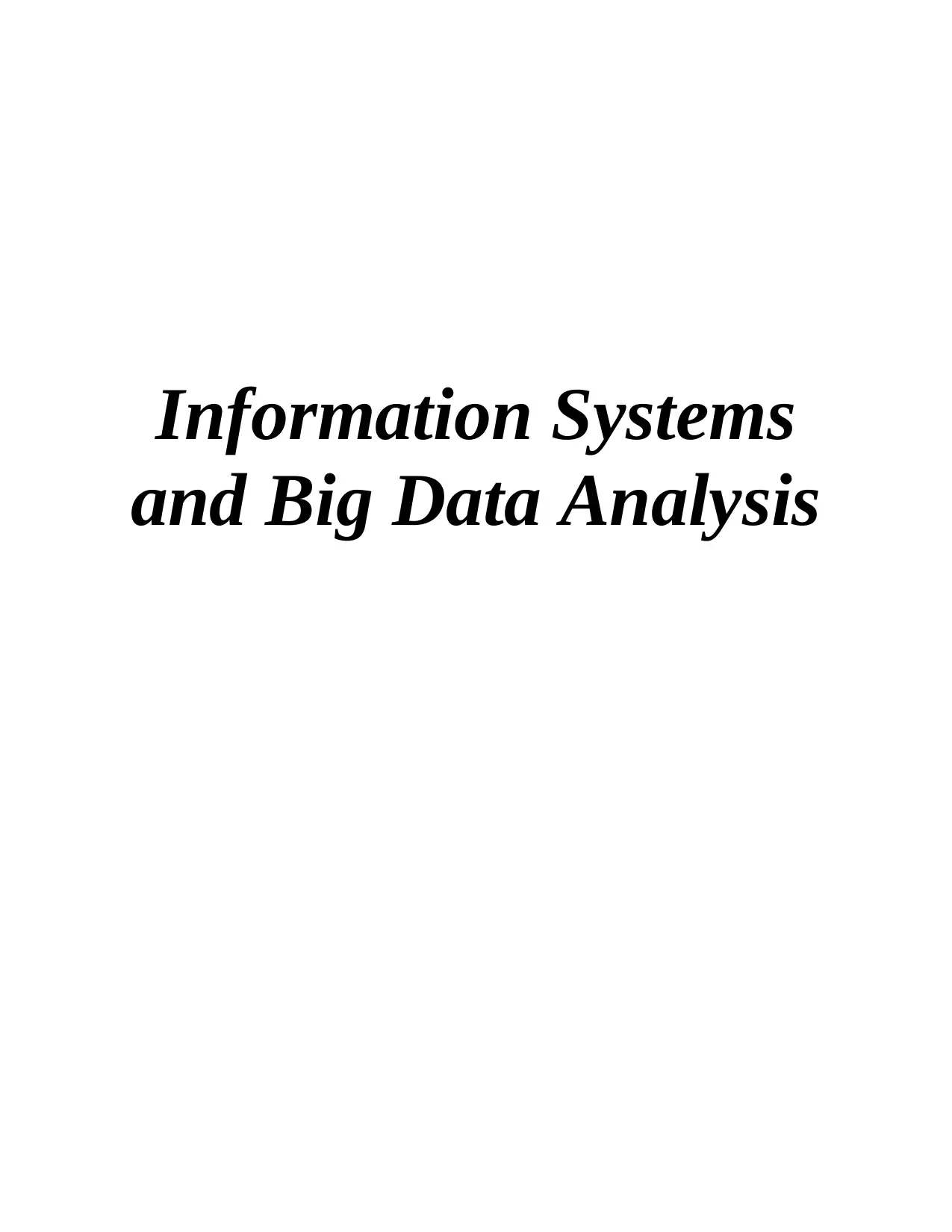
Information Systems
and Big Data Analysis
and Big Data Analysis
Secure Best Marks with AI Grader
Need help grading? Try our AI Grader for instant feedback on your assignments.
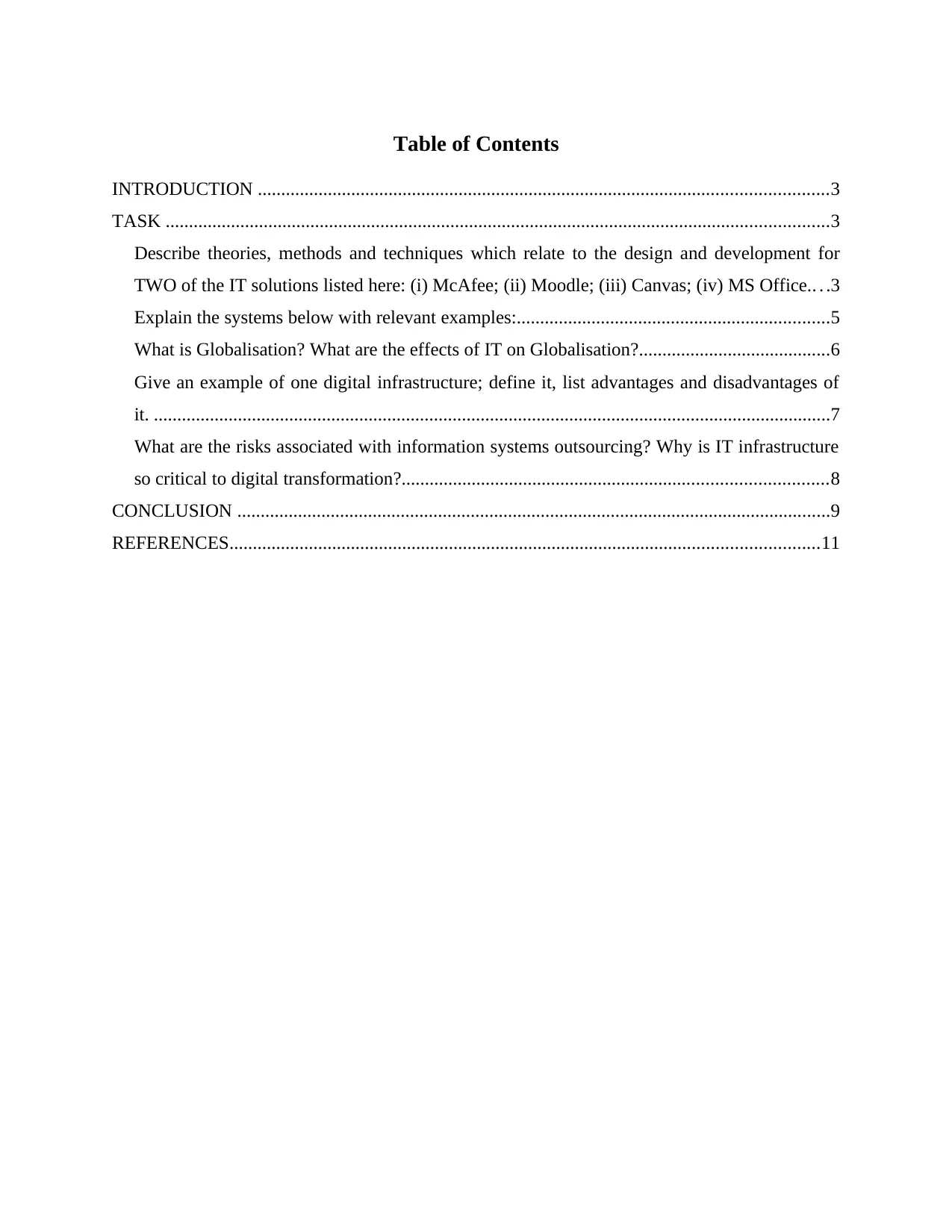
Table of Contents
INTRODUCTION ..........................................................................................................................3
TASK ..............................................................................................................................................3
Describe theories, methods and techniques which relate to the design and development for
TWO of the IT solutions listed here: (i) McAfee; (ii) Moodle; (iii) Canvas; (iv) MS Office.. . .3
Explain the systems below with relevant examples:...................................................................5
What is Globalisation? What are the effects of IT on Globalisation?.........................................6
Give an example of one digital infrastructure; define it, list advantages and disadvantages of
it. .................................................................................................................................................7
What are the risks associated with information systems outsourcing? Why is IT infrastructure
so critical to digital transformation?...........................................................................................8
CONCLUSION ...............................................................................................................................9
REFERENCES..............................................................................................................................11
INTRODUCTION ..........................................................................................................................3
TASK ..............................................................................................................................................3
Describe theories, methods and techniques which relate to the design and development for
TWO of the IT solutions listed here: (i) McAfee; (ii) Moodle; (iii) Canvas; (iv) MS Office.. . .3
Explain the systems below with relevant examples:...................................................................5
What is Globalisation? What are the effects of IT on Globalisation?.........................................6
Give an example of one digital infrastructure; define it, list advantages and disadvantages of
it. .................................................................................................................................................7
What are the risks associated with information systems outsourcing? Why is IT infrastructure
so critical to digital transformation?...........................................................................................8
CONCLUSION ...............................................................................................................................9
REFERENCES..............................................................................................................................11

INTRODUCTION
Data sets are quite varied when it comes to business and from these sets, big data is
extremely important from an organizational perspective as it's a huge collection of highly
complex data sets which aren't easily analysed by traditional data filtering technology. An
information system is a focused and streamlined pool of elements such as manpower,
information technology and operational machines. These components are integrated and used in
tandem in order to process business data and turn it into information relevant and beneficial for
business and help in seamless distribution and processing of information (Serrano,2018). These
information systems play a big role in big data analytics which refers to a complex and advanced
form of analysis of big data in order to enable data driven decision-making. This report aims to
shed light on the various information systems employed by businesses, their varied use, risks
associated and their overall effectiveness in modern day business.
TASK
Describe theories, methods and techniques which relate to the design and development for TWO
of the IT solutions listed here: (i) McAfee; (ii) Moodle; (iii) Canvas; (iv) MS Office.
McAfee-McAfee is a computer and data security giant founded in 1987 with the name of
McAfee associates, the name taken from it's founder, John McAfee. It is a company specializing
in security services and complete data protection from various artificial and non-artificial entities
via security software. Data and system security is paramount in today's style of conducting
business driven by digital growth and transformation as businesses increasingly handle big data
sets and sensitive client relevant information. McAfee provides a wide array of services for
robust protection of information listed herein(Schindler, and et. al., 2019). McAfee Total Protection-This is McAfee's most premium offering providing all around
protection for devices ranging from laptops all the way to smartphones. McAfee Gamer Security-Gaming goes hand in hand with virus and malware and the last
thing gamers need is a sabotage in the power and speed of their gaming devices. McAfee
provides secure protection from threats without any compromise in gaming performance.
Data sets are quite varied when it comes to business and from these sets, big data is
extremely important from an organizational perspective as it's a huge collection of highly
complex data sets which aren't easily analysed by traditional data filtering technology. An
information system is a focused and streamlined pool of elements such as manpower,
information technology and operational machines. These components are integrated and used in
tandem in order to process business data and turn it into information relevant and beneficial for
business and help in seamless distribution and processing of information (Serrano,2018). These
information systems play a big role in big data analytics which refers to a complex and advanced
form of analysis of big data in order to enable data driven decision-making. This report aims to
shed light on the various information systems employed by businesses, their varied use, risks
associated and their overall effectiveness in modern day business.
TASK
Describe theories, methods and techniques which relate to the design and development for TWO
of the IT solutions listed here: (i) McAfee; (ii) Moodle; (iii) Canvas; (iv) MS Office.
McAfee-McAfee is a computer and data security giant founded in 1987 with the name of
McAfee associates, the name taken from it's founder, John McAfee. It is a company specializing
in security services and complete data protection from various artificial and non-artificial entities
via security software. Data and system security is paramount in today's style of conducting
business driven by digital growth and transformation as businesses increasingly handle big data
sets and sensitive client relevant information. McAfee provides a wide array of services for
robust protection of information listed herein(Schindler, and et. al., 2019). McAfee Total Protection-This is McAfee's most premium offering providing all around
protection for devices ranging from laptops all the way to smartphones. McAfee Gamer Security-Gaming goes hand in hand with virus and malware and the last
thing gamers need is a sabotage in the power and speed of their gaming devices. McAfee
provides secure protection from threats without any compromise in gaming performance.

McAfee Web Advisor-It is a free windows platformed product by McAfee which fishes
out browser based scam adverts and blocks attempts made to manipulate and harm
information.
McAfee Identity Protection Service-This product by McAfee provides security to client's
private and sensitive information from hackers and unlawful access.
McAfee provides a slew of benefits to it's clients including maximum defence against malicious
viruses and malware, providing robust system security without any negative impact on a system's
components and performance. It also provides a host of other software services ranging from
centralized business management, protection from DDOS attacks and cloud security
management.
MS Office-MS Office came into effect from 1988 is an application based suite which is
one of the most successful efforts of Microsoft in the applications department and is considered
one of the crowning jewel in the field of computer technology. MS Office is the most extensively
used business oriented program across the world thanks to it's ease of access, variety of features
and sheer level of adaptability across all operating systems. MS office is a complete package full
of hallmark application and services listed herein. MS Word-It is a world class word processor by Microsoft which also has superb
efficiency in other uses such as business document creation, desktop editing and
publishing and data handling. MS Excel-It is a spreadsheet program primarily used to process and analyse data of
numerical nature. It helps an organization in it's marketing, product catalogue
management and it's financial and accounting needs (Oksiiuk, Chaikovska, and Fesenko,
2020)
MS PowerPoint-It is the flagship presentation program in the product offerings of
Microsoft and it's main use is streamlining important presentations and it can also be used
to interpret and forecast business financials and related reports.
Microsoft office is used by almost every individual and organization in the world in varying
degrees of usage and this is made possible due to it's impeccable design catering to personalised
and mass needs. The barrier to learning isn't high as well which results in ease of client usage. It
offers information solutions of almost every kind packaged inside one big application suite
out browser based scam adverts and blocks attempts made to manipulate and harm
information.
McAfee Identity Protection Service-This product by McAfee provides security to client's
private and sensitive information from hackers and unlawful access.
McAfee provides a slew of benefits to it's clients including maximum defence against malicious
viruses and malware, providing robust system security without any negative impact on a system's
components and performance. It also provides a host of other software services ranging from
centralized business management, protection from DDOS attacks and cloud security
management.
MS Office-MS Office came into effect from 1988 is an application based suite which is
one of the most successful efforts of Microsoft in the applications department and is considered
one of the crowning jewel in the field of computer technology. MS Office is the most extensively
used business oriented program across the world thanks to it's ease of access, variety of features
and sheer level of adaptability across all operating systems. MS office is a complete package full
of hallmark application and services listed herein. MS Word-It is a world class word processor by Microsoft which also has superb
efficiency in other uses such as business document creation, desktop editing and
publishing and data handling. MS Excel-It is a spreadsheet program primarily used to process and analyse data of
numerical nature. It helps an organization in it's marketing, product catalogue
management and it's financial and accounting needs (Oksiiuk, Chaikovska, and Fesenko,
2020)
MS PowerPoint-It is the flagship presentation program in the product offerings of
Microsoft and it's main use is streamlining important presentations and it can also be used
to interpret and forecast business financials and related reports.
Microsoft office is used by almost every individual and organization in the world in varying
degrees of usage and this is made possible due to it's impeccable design catering to personalised
and mass needs. The barrier to learning isn't high as well which results in ease of client usage. It
offers information solutions of almost every kind packaged inside one big application suite
Secure Best Marks with AI Grader
Need help grading? Try our AI Grader for instant feedback on your assignments.

which makes it the first choice of many and the reason why it comes pre-installed in every major
device.
Explain the systems below with relevant examples:
DSS (Decision Support System)-It is an information system which is manpower oriented,
fully automated and often times a combination of both whose primary purpose is to filter through
large, unstructured pools of data and collecting bits of information relevant to the task at hand. It
helps in making rational and informed decisions based on data driven holistic information. DSS
are used at different levels and has various purposes such as the GPS on your phone which
accurately describes the best possible route between two set locations, software used by medical
professionals to diagnose disease patterns all the way to business prediction tools and DSS
modelling to study future trends(Montealegre, and et. al., 2020).
ESS (Executive Support System)-These information systems convert business data into
executive level reports for quick analysis and usage by various business departments such as
accounting and staffing. ESS is very helpful for senior management in an organization as it
provides analysis utilities while also helping put in place performance assessment data points.
ESS can be easily customized to suit organizational needs as there is Meditech which is used in
the healthcare industry while Cambridge Systematics, a transportation consultancy firm has it's
own custom made ESS which aids the transportation ministry in making planned investments.
TPS (Transaction Processing System)-It is a variety of information system which is used
to accumulate, restore, stockpile and alter data related to client and business transactions. It
occurs in both real time transactions which happens simultaneously without delay and batch
processing which involves multiple different components. A TPS includes many components
ranging from inputs such as bills and invoices, outputs comprising of transaction verifying
documents such as receipts, electronically storing this data in databases and processing this
information in a streamlined manner. Real time TPS is used in transaction heavy areas such as
retail establishments and reservation systems and batch processing TPS is mainly seen in credit
card transactions (Kalaiprasath, and et. al., 2020).
MIS (Management Information System)-It is a broad collection of information systems
comprising of manpower, technology, business enterprises and the dynamic shared between the
three of them. MIS is employed by businesses at each and every level of the organization as it
plays an active role in collection, processing and streamlining of relevant information from big
device.
Explain the systems below with relevant examples:
DSS (Decision Support System)-It is an information system which is manpower oriented,
fully automated and often times a combination of both whose primary purpose is to filter through
large, unstructured pools of data and collecting bits of information relevant to the task at hand. It
helps in making rational and informed decisions based on data driven holistic information. DSS
are used at different levels and has various purposes such as the GPS on your phone which
accurately describes the best possible route between two set locations, software used by medical
professionals to diagnose disease patterns all the way to business prediction tools and DSS
modelling to study future trends(Montealegre, and et. al., 2020).
ESS (Executive Support System)-These information systems convert business data into
executive level reports for quick analysis and usage by various business departments such as
accounting and staffing. ESS is very helpful for senior management in an organization as it
provides analysis utilities while also helping put in place performance assessment data points.
ESS can be easily customized to suit organizational needs as there is Meditech which is used in
the healthcare industry while Cambridge Systematics, a transportation consultancy firm has it's
own custom made ESS which aids the transportation ministry in making planned investments.
TPS (Transaction Processing System)-It is a variety of information system which is used
to accumulate, restore, stockpile and alter data related to client and business transactions. It
occurs in both real time transactions which happens simultaneously without delay and batch
processing which involves multiple different components. A TPS includes many components
ranging from inputs such as bills and invoices, outputs comprising of transaction verifying
documents such as receipts, electronically storing this data in databases and processing this
information in a streamlined manner. Real time TPS is used in transaction heavy areas such as
retail establishments and reservation systems and batch processing TPS is mainly seen in credit
card transactions (Kalaiprasath, and et. al., 2020).
MIS (Management Information System)-It is a broad collection of information systems
comprising of manpower, technology, business enterprises and the dynamic shared between the
three of them. MIS is employed by businesses at each and every level of the organization as it
plays an active role in collection, processing and streamlining of relevant information from big
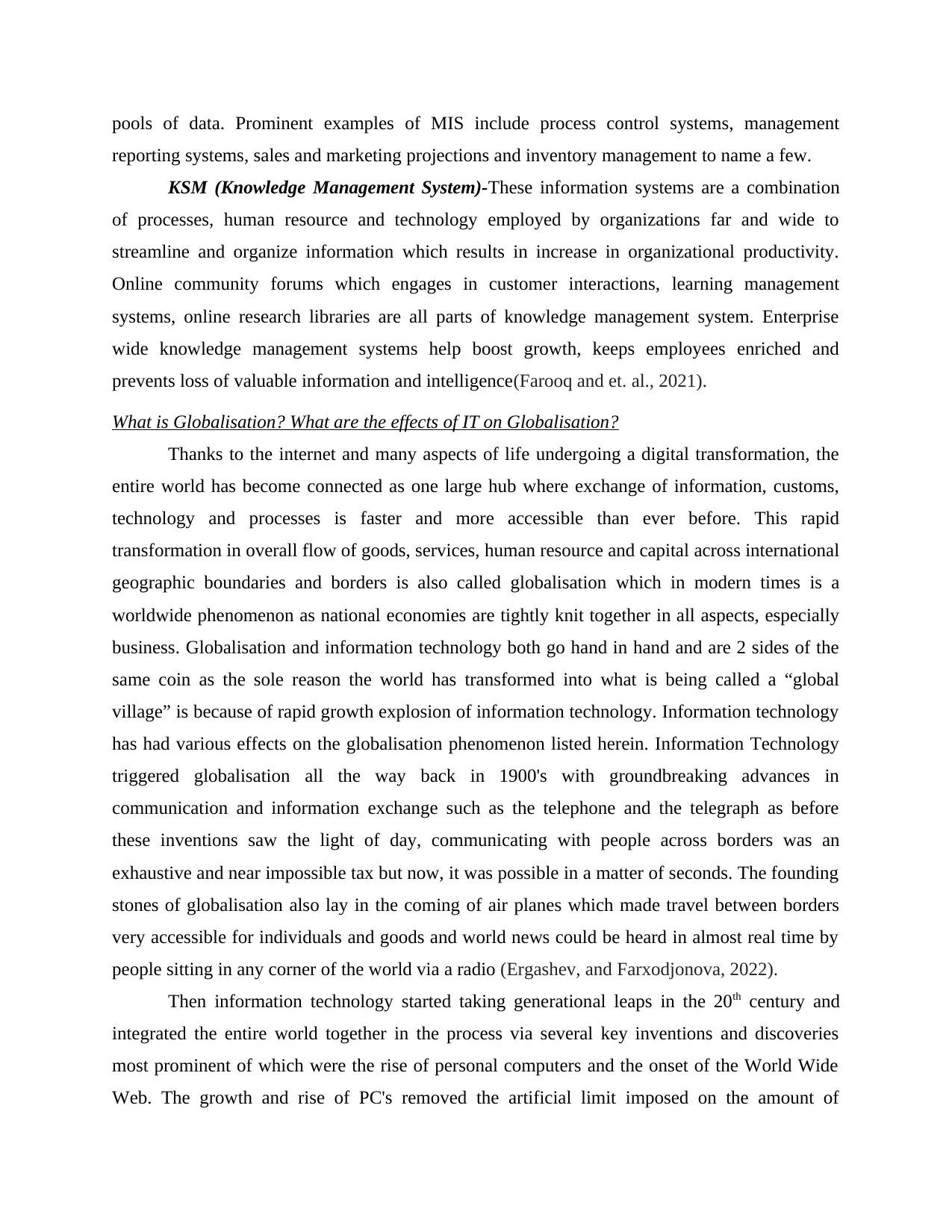
pools of data. Prominent examples of MIS include process control systems, management
reporting systems, sales and marketing projections and inventory management to name a few.
KSM (Knowledge Management System)-These information systems are a combination
of processes, human resource and technology employed by organizations far and wide to
streamline and organize information which results in increase in organizational productivity.
Online community forums which engages in customer interactions, learning management
systems, online research libraries are all parts of knowledge management system. Enterprise
wide knowledge management systems help boost growth, keeps employees enriched and
prevents loss of valuable information and intelligence(Farooq and et. al., 2021).
What is Globalisation? What are the effects of IT on Globalisation?
Thanks to the internet and many aspects of life undergoing a digital transformation, the
entire world has become connected as one large hub where exchange of information, customs,
technology and processes is faster and more accessible than ever before. This rapid
transformation in overall flow of goods, services, human resource and capital across international
geographic boundaries and borders is also called globalisation which in modern times is a
worldwide phenomenon as national economies are tightly knit together in all aspects, especially
business. Globalisation and information technology both go hand in hand and are 2 sides of the
same coin as the sole reason the world has transformed into what is being called a “global
village” is because of rapid growth explosion of information technology. Information technology
has had various effects on the globalisation phenomenon listed herein. Information Technology
triggered globalisation all the way back in 1900's with groundbreaking advances in
communication and information exchange such as the telephone and the telegraph as before
these inventions saw the light of day, communicating with people across borders was an
exhaustive and near impossible tax but now, it was possible in a matter of seconds. The founding
stones of globalisation also lay in the coming of air planes which made travel between borders
very accessible for individuals and goods and world news could be heard in almost real time by
people sitting in any corner of the world via a radio (Ergashev, and Farxodjonova, 2022).
Then information technology started taking generational leaps in the 20th century and
integrated the entire world together in the process via several key inventions and discoveries
most prominent of which were the rise of personal computers and the onset of the World Wide
Web. The growth and rise of PC's removed the artificial limit imposed on the amount of
reporting systems, sales and marketing projections and inventory management to name a few.
KSM (Knowledge Management System)-These information systems are a combination
of processes, human resource and technology employed by organizations far and wide to
streamline and organize information which results in increase in organizational productivity.
Online community forums which engages in customer interactions, learning management
systems, online research libraries are all parts of knowledge management system. Enterprise
wide knowledge management systems help boost growth, keeps employees enriched and
prevents loss of valuable information and intelligence(Farooq and et. al., 2021).
What is Globalisation? What are the effects of IT on Globalisation?
Thanks to the internet and many aspects of life undergoing a digital transformation, the
entire world has become connected as one large hub where exchange of information, customs,
technology and processes is faster and more accessible than ever before. This rapid
transformation in overall flow of goods, services, human resource and capital across international
geographic boundaries and borders is also called globalisation which in modern times is a
worldwide phenomenon as national economies are tightly knit together in all aspects, especially
business. Globalisation and information technology both go hand in hand and are 2 sides of the
same coin as the sole reason the world has transformed into what is being called a “global
village” is because of rapid growth explosion of information technology. Information technology
has had various effects on the globalisation phenomenon listed herein. Information Technology
triggered globalisation all the way back in 1900's with groundbreaking advances in
communication and information exchange such as the telephone and the telegraph as before
these inventions saw the light of day, communicating with people across borders was an
exhaustive and near impossible tax but now, it was possible in a matter of seconds. The founding
stones of globalisation also lay in the coming of air planes which made travel between borders
very accessible for individuals and goods and world news could be heard in almost real time by
people sitting in any corner of the world via a radio (Ergashev, and Farxodjonova, 2022).
Then information technology started taking generational leaps in the 20th century and
integrated the entire world together in the process via several key inventions and discoveries
most prominent of which were the rise of personal computers and the onset of the World Wide
Web. The growth and rise of PC's removed the artificial limit imposed on the amount of
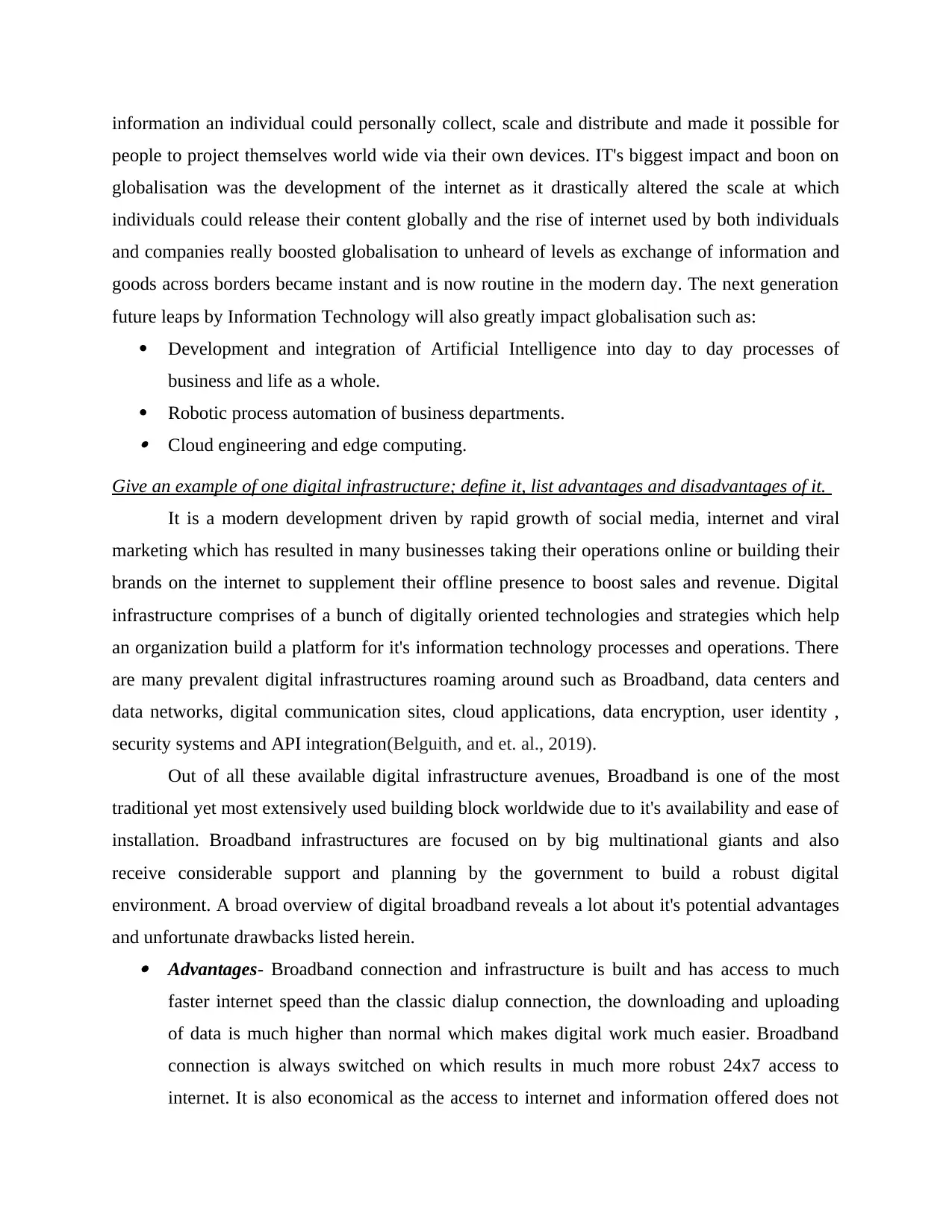
information an individual could personally collect, scale and distribute and made it possible for
people to project themselves world wide via their own devices. IT's biggest impact and boon on
globalisation was the development of the internet as it drastically altered the scale at which
individuals could release their content globally and the rise of internet used by both individuals
and companies really boosted globalisation to unheard of levels as exchange of information and
goods across borders became instant and is now routine in the modern day. The next generation
future leaps by Information Technology will also greatly impact globalisation such as:
Development and integration of Artificial Intelligence into day to day processes of
business and life as a whole.
Robotic process automation of business departments. Cloud engineering and edge computing.
Give an example of one digital infrastructure; define it, list advantages and disadvantages of it.
It is a modern development driven by rapid growth of social media, internet and viral
marketing which has resulted in many businesses taking their operations online or building their
brands on the internet to supplement their offline presence to boost sales and revenue. Digital
infrastructure comprises of a bunch of digitally oriented technologies and strategies which help
an organization build a platform for it's information technology processes and operations. There
are many prevalent digital infrastructures roaming around such as Broadband, data centers and
data networks, digital communication sites, cloud applications, data encryption, user identity ,
security systems and API integration(Belguith, and et. al., 2019).
Out of all these available digital infrastructure avenues, Broadband is one of the most
traditional yet most extensively used building block worldwide due to it's availability and ease of
installation. Broadband infrastructures are focused on by big multinational giants and also
receive considerable support and planning by the government to build a robust digital
environment. A broad overview of digital broadband reveals a lot about it's potential advantages
and unfortunate drawbacks listed herein. Advantages- Broadband connection and infrastructure is built and has access to much
faster internet speed than the classic dialup connection, the downloading and uploading
of data is much higher than normal which makes digital work much easier. Broadband
connection is always switched on which results in much more robust 24x7 access to
internet. It is also economical as the access to internet and information offered does not
people to project themselves world wide via their own devices. IT's biggest impact and boon on
globalisation was the development of the internet as it drastically altered the scale at which
individuals could release their content globally and the rise of internet used by both individuals
and companies really boosted globalisation to unheard of levels as exchange of information and
goods across borders became instant and is now routine in the modern day. The next generation
future leaps by Information Technology will also greatly impact globalisation such as:
Development and integration of Artificial Intelligence into day to day processes of
business and life as a whole.
Robotic process automation of business departments. Cloud engineering and edge computing.
Give an example of one digital infrastructure; define it, list advantages and disadvantages of it.
It is a modern development driven by rapid growth of social media, internet and viral
marketing which has resulted in many businesses taking their operations online or building their
brands on the internet to supplement their offline presence to boost sales and revenue. Digital
infrastructure comprises of a bunch of digitally oriented technologies and strategies which help
an organization build a platform for it's information technology processes and operations. There
are many prevalent digital infrastructures roaming around such as Broadband, data centers and
data networks, digital communication sites, cloud applications, data encryption, user identity ,
security systems and API integration(Belguith, and et. al., 2019).
Out of all these available digital infrastructure avenues, Broadband is one of the most
traditional yet most extensively used building block worldwide due to it's availability and ease of
installation. Broadband infrastructures are focused on by big multinational giants and also
receive considerable support and planning by the government to build a robust digital
environment. A broad overview of digital broadband reveals a lot about it's potential advantages
and unfortunate drawbacks listed herein. Advantages- Broadband connection and infrastructure is built and has access to much
faster internet speed than the classic dialup connection, the downloading and uploading
of data is much higher than normal which makes digital work much easier. Broadband
connection is always switched on which results in much more robust 24x7 access to
internet. It is also economical as the access to internet and information offered does not
Paraphrase This Document
Need a fresh take? Get an instant paraphrase of this document with our AI Paraphraser

have any imposed limits and charges aren't based on duration of the connection.
Broadband infrastructures can also take advantage of it's VolP technology to improve
their phone services. Disadvantages-Broadband infrastructures sadly suffer from some notable drawbacks as
they are more expensive than the classic dialup connection even if they're superior in
quality. Broadband infrastructures aren't secure too because a firewall has to be erected in
all the involved systems for security purposes and the setups offered by broadband are
geographically dependant for performance as remote areas aren't supported and serviced
well.
What are the risks associated with information systems outsourcing? Why is IT infrastructure so
critical to digital transformation?
Outsourcing is a widespread business process undertaken across a variety of businesses
worldwide as it helps an organization save both time and money by taking help of the immensely
talented global talent pool and strategic expertise of specialised third party solutions provider.
Information Systems are also subject to competent and widespread outsourcing as they are a vital
component of a business's digital infrastructure. Information Systems outsourcing basically
means the handling of the storage and collection of data and handling of various MIS by external
service providers. IS outsourcing has grown leaps and bounds over the years as it has turned
from a single contracted payment for a small scale operation to full blown transfer of assets and
personnel for profit and loss handling (Bearden, and Lo, 2021).
However with immense growth, it also has it's fair share of risks involved for a business
which are listed herein. Unproductive and unskilled personnel-Using the external handling of information
systems can lead to unfavourable outcomes as the business knows next to nothing about
the people involved with the information system as opposed to internal handling where
one can know everything there is to know about the skill and expertise of an employee. Dilution of control-Deciding to outsource an information system to a third party can be
detrimental for a business in the long run if it becomes too dependant on the third party as
it have to play by it's rules, forcefully accept technological changes brought about in it's
information systems and the business will have to bear the full brunt of any structural
changes done to it's IS by the third party.
Broadband infrastructures can also take advantage of it's VolP technology to improve
their phone services. Disadvantages-Broadband infrastructures sadly suffer from some notable drawbacks as
they are more expensive than the classic dialup connection even if they're superior in
quality. Broadband infrastructures aren't secure too because a firewall has to be erected in
all the involved systems for security purposes and the setups offered by broadband are
geographically dependant for performance as remote areas aren't supported and serviced
well.
What are the risks associated with information systems outsourcing? Why is IT infrastructure so
critical to digital transformation?
Outsourcing is a widespread business process undertaken across a variety of businesses
worldwide as it helps an organization save both time and money by taking help of the immensely
talented global talent pool and strategic expertise of specialised third party solutions provider.
Information Systems are also subject to competent and widespread outsourcing as they are a vital
component of a business's digital infrastructure. Information Systems outsourcing basically
means the handling of the storage and collection of data and handling of various MIS by external
service providers. IS outsourcing has grown leaps and bounds over the years as it has turned
from a single contracted payment for a small scale operation to full blown transfer of assets and
personnel for profit and loss handling (Bearden, and Lo, 2021).
However with immense growth, it also has it's fair share of risks involved for a business
which are listed herein. Unproductive and unskilled personnel-Using the external handling of information
systems can lead to unfavourable outcomes as the business knows next to nothing about
the people involved with the information system as opposed to internal handling where
one can know everything there is to know about the skill and expertise of an employee. Dilution of control-Deciding to outsource an information system to a third party can be
detrimental for a business in the long run if it becomes too dependant on the third party as
it have to play by it's rules, forcefully accept technological changes brought about in it's
information systems and the business will have to bear the full brunt of any structural
changes done to it's IS by the third party.
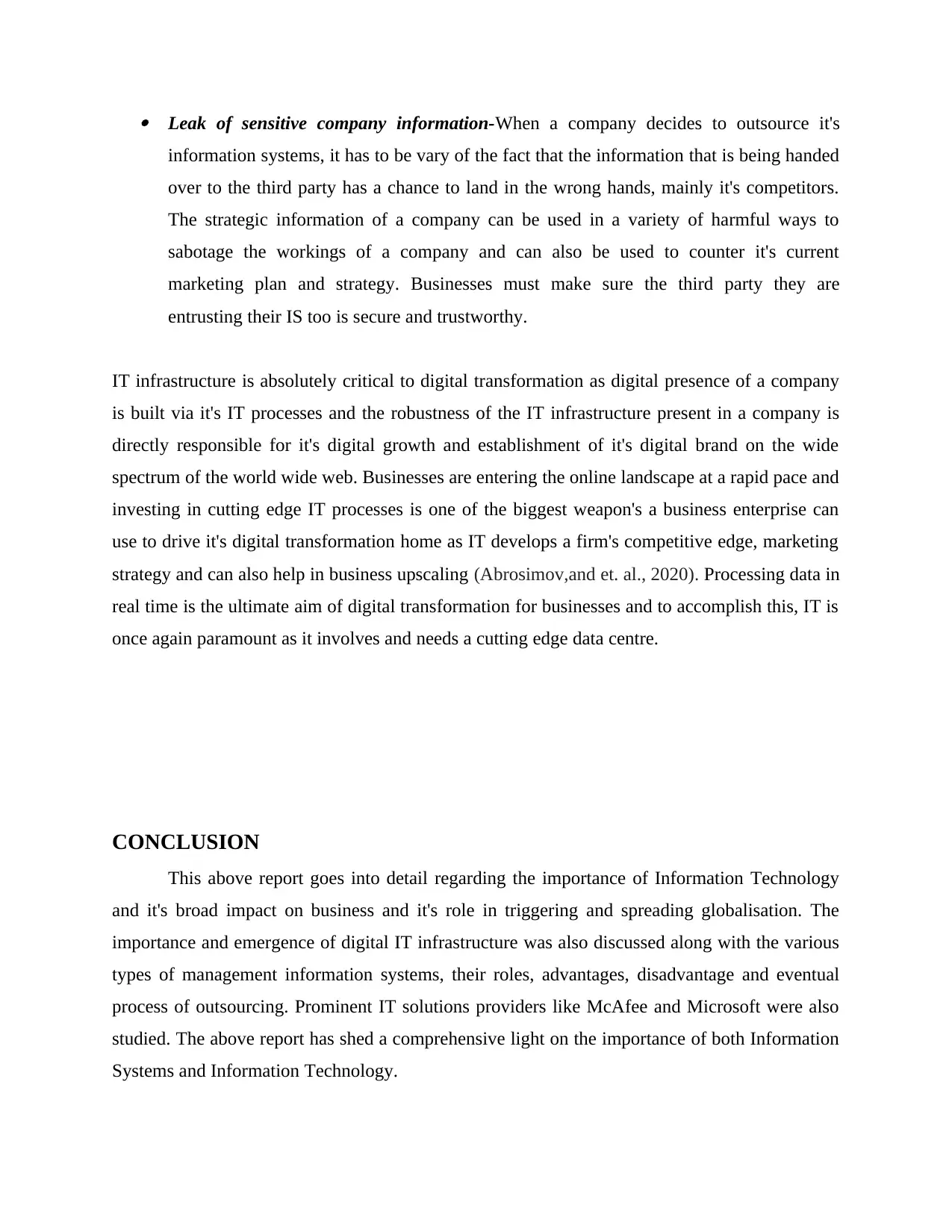
Leak of sensitive company information-When a company decides to outsource it's
information systems, it has to be vary of the fact that the information that is being handed
over to the third party has a chance to land in the wrong hands, mainly it's competitors.
The strategic information of a company can be used in a variety of harmful ways to
sabotage the workings of a company and can also be used to counter it's current
marketing plan and strategy. Businesses must make sure the third party they are
entrusting their IS too is secure and trustworthy.
IT infrastructure is absolutely critical to digital transformation as digital presence of a company
is built via it's IT processes and the robustness of the IT infrastructure present in a company is
directly responsible for it's digital growth and establishment of it's digital brand on the wide
spectrum of the world wide web. Businesses are entering the online landscape at a rapid pace and
investing in cutting edge IT processes is one of the biggest weapon's a business enterprise can
use to drive it's digital transformation home as IT develops a firm's competitive edge, marketing
strategy and can also help in business upscaling (Abrosimov,and et. al., 2020). Processing data in
real time is the ultimate aim of digital transformation for businesses and to accomplish this, IT is
once again paramount as it involves and needs a cutting edge data centre.
CONCLUSION
This above report goes into detail regarding the importance of Information Technology
and it's broad impact on business and it's role in triggering and spreading globalisation. The
importance and emergence of digital IT infrastructure was also discussed along with the various
types of management information systems, their roles, advantages, disadvantage and eventual
process of outsourcing. Prominent IT solutions providers like McAfee and Microsoft were also
studied. The above report has shed a comprehensive light on the importance of both Information
Systems and Information Technology.
information systems, it has to be vary of the fact that the information that is being handed
over to the third party has a chance to land in the wrong hands, mainly it's competitors.
The strategic information of a company can be used in a variety of harmful ways to
sabotage the workings of a company and can also be used to counter it's current
marketing plan and strategy. Businesses must make sure the third party they are
entrusting their IS too is secure and trustworthy.
IT infrastructure is absolutely critical to digital transformation as digital presence of a company
is built via it's IT processes and the robustness of the IT infrastructure present in a company is
directly responsible for it's digital growth and establishment of it's digital brand on the wide
spectrum of the world wide web. Businesses are entering the online landscape at a rapid pace and
investing in cutting edge IT processes is one of the biggest weapon's a business enterprise can
use to drive it's digital transformation home as IT develops a firm's competitive edge, marketing
strategy and can also help in business upscaling (Abrosimov,and et. al., 2020). Processing data in
real time is the ultimate aim of digital transformation for businesses and to accomplish this, IT is
once again paramount as it involves and needs a cutting edge data centre.
CONCLUSION
This above report goes into detail regarding the importance of Information Technology
and it's broad impact on business and it's role in triggering and spreading globalisation. The
importance and emergence of digital IT infrastructure was also discussed along with the various
types of management information systems, their roles, advantages, disadvantage and eventual
process of outsourcing. Prominent IT solutions providers like McAfee and Microsoft were also
studied. The above report has shed a comprehensive light on the importance of both Information
Systems and Information Technology.

Secure Best Marks with AI Grader
Need help grading? Try our AI Grader for instant feedback on your assignments.
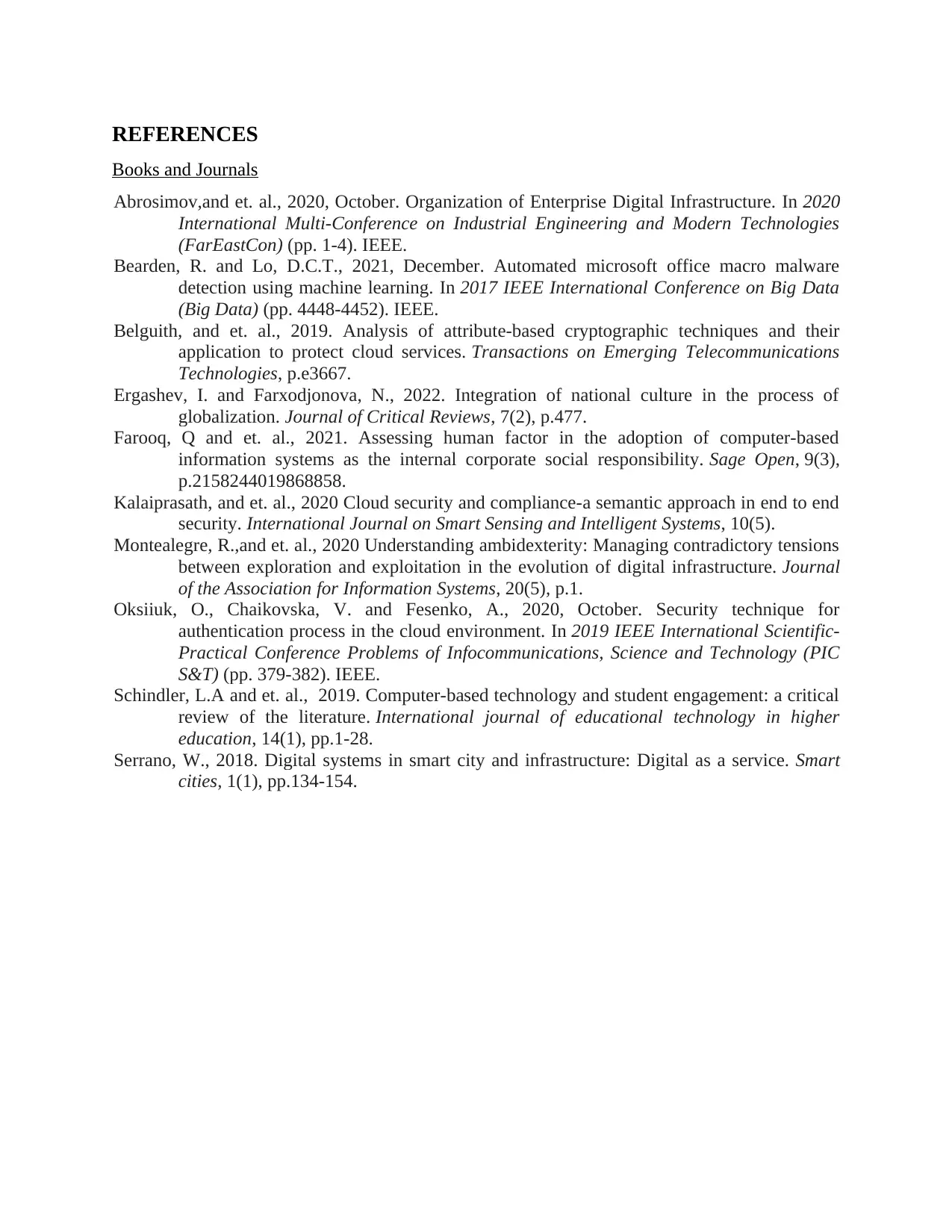
REFERENCES
Books and Journals
Abrosimov,and et. al., 2020, October. Organization of Enterprise Digital Infrastructure. In 2020
International Multi-Conference on Industrial Engineering and Modern Technologies
(FarEastCon) (pp. 1-4). IEEE.
Bearden, R. and Lo, D.C.T., 2021, December. Automated microsoft office macro malware
detection using machine learning. In 2017 IEEE International Conference on Big Data
(Big Data) (pp. 4448-4452). IEEE.
Belguith, and et. al., 2019. Analysis of attribute‐based cryptographic techniques and their
application to protect cloud services. Transactions on Emerging Telecommunications
Technologies, p.e3667.
Ergashev, I. and Farxodjonova, N., 2022. Integration of national culture in the process of
globalization. Journal of Critical Reviews, 7(2), p.477.
Farooq, Q and et. al., 2021. Assessing human factor in the adoption of computer-based
information systems as the internal corporate social responsibility. Sage Open, 9(3),
p.2158244019868858.
Kalaiprasath, and et. al., 2020 Cloud security and compliance-a semantic approach in end to end
security. International Journal on Smart Sensing and Intelligent Systems, 10(5).
Montealegre, R.,and et. al., 2020 Understanding ambidexterity: Managing contradictory tensions
between exploration and exploitation in the evolution of digital infrastructure. Journal
of the Association for Information Systems, 20(5), p.1.
Oksiiuk, O., Chaikovska, V. and Fesenko, A., 2020, October. Security technique for
authentication process in the cloud environment. In 2019 IEEE International Scientific-
Practical Conference Problems of Infocommunications, Science and Technology (PIC
S&T) (pp. 379-382). IEEE.
Schindler, L.A and et. al., 2019. Computer-based technology and student engagement: a critical
review of the literature. International journal of educational technology in higher
education, 14(1), pp.1-28.
Serrano, W., 2018. Digital systems in smart city and infrastructure: Digital as a service. Smart
cities, 1(1), pp.134-154.
Books and Journals
Abrosimov,and et. al., 2020, October. Organization of Enterprise Digital Infrastructure. In 2020
International Multi-Conference on Industrial Engineering and Modern Technologies
(FarEastCon) (pp. 1-4). IEEE.
Bearden, R. and Lo, D.C.T., 2021, December. Automated microsoft office macro malware
detection using machine learning. In 2017 IEEE International Conference on Big Data
(Big Data) (pp. 4448-4452). IEEE.
Belguith, and et. al., 2019. Analysis of attribute‐based cryptographic techniques and their
application to protect cloud services. Transactions on Emerging Telecommunications
Technologies, p.e3667.
Ergashev, I. and Farxodjonova, N., 2022. Integration of national culture in the process of
globalization. Journal of Critical Reviews, 7(2), p.477.
Farooq, Q and et. al., 2021. Assessing human factor in the adoption of computer-based
information systems as the internal corporate social responsibility. Sage Open, 9(3),
p.2158244019868858.
Kalaiprasath, and et. al., 2020 Cloud security and compliance-a semantic approach in end to end
security. International Journal on Smart Sensing and Intelligent Systems, 10(5).
Montealegre, R.,and et. al., 2020 Understanding ambidexterity: Managing contradictory tensions
between exploration and exploitation in the evolution of digital infrastructure. Journal
of the Association for Information Systems, 20(5), p.1.
Oksiiuk, O., Chaikovska, V. and Fesenko, A., 2020, October. Security technique for
authentication process in the cloud environment. In 2019 IEEE International Scientific-
Practical Conference Problems of Infocommunications, Science and Technology (PIC
S&T) (pp. 379-382). IEEE.
Schindler, L.A and et. al., 2019. Computer-based technology and student engagement: a critical
review of the literature. International journal of educational technology in higher
education, 14(1), pp.1-28.
Serrano, W., 2018. Digital systems in smart city and infrastructure: Digital as a service. Smart
cities, 1(1), pp.134-154.
1 out of 11
Related Documents
Your All-in-One AI-Powered Toolkit for Academic Success.
+13062052269
info@desklib.com
Available 24*7 on WhatsApp / Email
![[object Object]](/_next/static/media/star-bottom.7253800d.svg)
Unlock your academic potential
© 2024 | Zucol Services PVT LTD | All rights reserved.